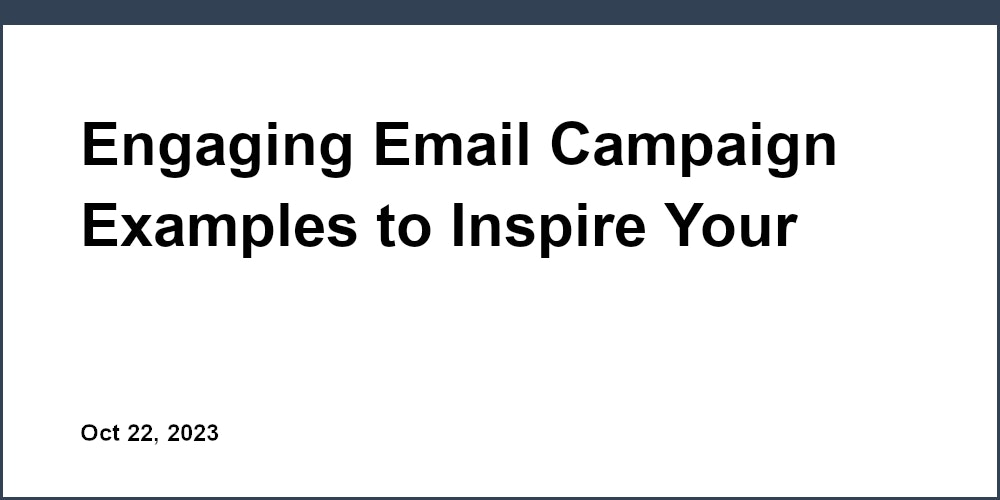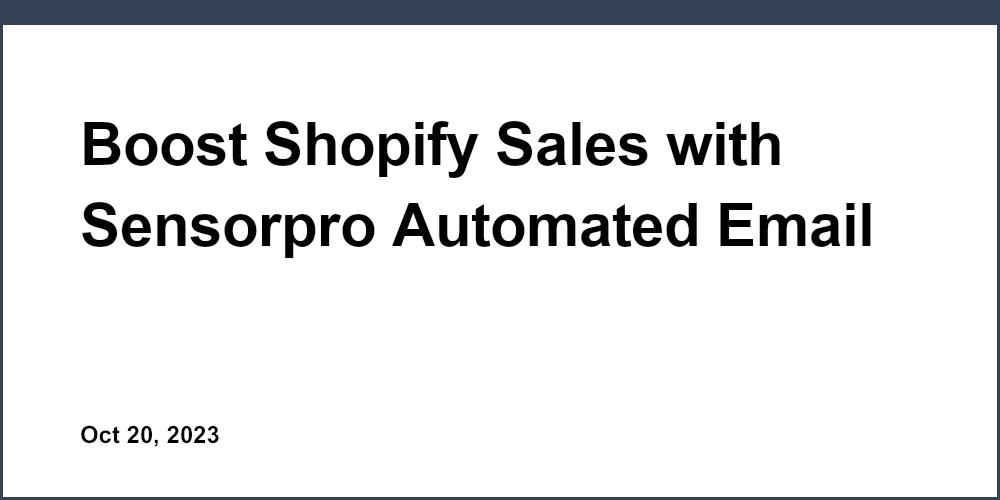Email marketing remains one of the most effective digital marketing channels, providing one of the highest returns on investment when executed properly. While consumer habits and technologies continue to evolve, the fundamentals of email success have remained consistent - crafting campaigns based on strategic best practices. By understanding your audience, setting clear goals, creating relevant content, optimizing deliverability, leveraging automation, continually testing, and analyzing performance, you can maximize the impact of your email efforts. In this post, we'll explore some of the most vital tactics and tips for planning, executing, and optimizing successful email marketing campaigns.
Introducing Effective Email Marketing Campaigns
Email marketing campaigns refer to coordinated, targeted email blasts sent to subscriber lists in order to meet specific business objectives. For many companies today, email campaigns represent one of the most cost-efficient tactics for customer acquisition, engagement, retention, and sales.
Despite the rise of modern channels like social media, SMS, and live chat, email continues to offer exceptional ROI compared to other formats. Studies show that for every $1 spent, email marketing generates an average return of $42 - outpacing other online channels. These campaigns build meaningful customer relationships, provide personalized experiences, and allow convenient communication on the subscriber’s terms.
However, achieving email success takes more than just blasting messages out to your contact list. Changing consumer habits, tighter regulations, and crowded inboxes require implementing smart email marketing strategies. By following the tips covered in this article, you can plan, create, execute, and optimize campaigns that cut through the noise to deliver real results. Let's examine some of the most critical components for email domination.
Understanding Your Audience
The foundation of any successful marketing plan is a deep understanding of your target customers. For email campaigns, thoroughly research subscriber demographics, interests, pain points, and behaviors. Build detailed buyer personas that allow you to segment your list based on attributes like location, purchase history, job title, and more. Identify the motivations and messaging that resonates with each audience group. For example, special offers and discounts may appeal to price-conscious subscribers, while industry leaders may respond better to thought leadership content.
Conduct surveys, analyze past campaign data, and continually update subscriber profiles to gain direct feedback and insights over time. With this level of audience understanding, you can tailor the tone, offers, design, and other campaign elements based on the unique attributes of each segment. Ultimately, the content must provide genuine value aligned with what each group cares about.
Setting Clear Campaign Goals
The most effective email campaigns align with specific, measurable business goals. Clearly outline the desired objectives you want to achieve such as email signups, free trial starts, product purchases, event registrations, or other conversions. For example, you may set a goal of increasing trial signups by 15% over 6 weeks. Choose relevant metrics you can track for each goal like open rates, clickthrough rates, and conversion rates. Study past campaign performance and analytics to determine realistic yet ambitious targets for each metric. Confirm that your email goals support wider business KPIs and objectives as well. With concrete goals established, you can craft content and optimize campaigns for maximum impact.
Creating Relevant, Valuable Content
Email copy, offers, and design should directly reflect the interests and needs of your subscribers. Leverage different formats like text, images, gifs, video, and more to create dynamic content. Focus on educating readers or solving their problems rather than overt brand promotion. Craft subject lines that highlight the specific benefits the reader will receive. Write concise body copy with scannable formatting. Personalize content by integrating dynamic details like subscriber names and location. Provide tailored offers or recommendations based on interests and behaviors. Ultimately, the content quality and relevance determines whether recipients open, engage with, and act on your email campaigns. Put subscriber value first.
Optimizing Deliverability
With crowded inboxes and complex filters, getting your emails delivered is vital. Follow CAN-SPAM guidelines and regularly prune your list to remove inactive contacts. Require double opt-in and include permission reminders. Carefully configure SPF, DKIM, and DMARC settings through a provider like SensorPro to authenticate your domain. Monitor sender reputation and blacklist statuses across major ISPs. Optimizing deliverability takes ongoing effort, but ensures your messages reliably reach subscriber inboxes.
Automating Workflows
Leverage email marketing automation to save time, provide consistency, and scale campaigns. Build sequences like post-purchase surveys, win-back offers for inactive users, or abandoned cart savings. Set up conditional branching based on user behaviors and attributes. Use templates to rapidly replicate top performing emails. Automate timely, relevant follow-up and behavioral-based triggering emails as well.
Testing and Optimization
Continually test and optimize your email campaigns. A/B test factors like subject lines, content formats, calls to action, timing, lists, and design templates. Analyze open rates, clickthrough rates, and conversion rates across devices, audience segments, and lifecycles. Double down on what converts while eliminating ineffective elements. Apply these learnings to each new campaign to maximize impact over time.
Measuring Performance
Regularly analyze email and website analytics to gauge campaign effectiveness. Assess performance against the specific goals defined early on. Calculate conversion rates, ROI, and revenue driven for different segments. Monitor unsubscribes and spam complaints as well. Identify strengths to build on and weaknesses to improve. Share results with internal teams to both celebrate wins and realign on areas needing refinement. Continual optimization requires diligently monitoring and acting on performance data.
Key Email Marketing Campaign Best Practices
Let's summarize some of the most vital tips for executing winning email campaigns in an easy checklist:
- Research audience insights and create detailed buyer personas
- Set specific, measurable goals tied to business objectives
- Segment your list and customize content for each group
- Produce genuinely valuable content focused on subscriber needs
- Ensure subject lines highlight content benefits clearly
- Optimize copy, design, and deliverability for mobile users
- Automate workflows like welcome series and re-engagement tracks
- Use A/B testing to determine optimal design, content, timing, etc.
- Monitor opens, CTRs, conversions, ROI, unsubscribes, and complaints
- Continually refine based on performance data and optimization tests
Getting email marketing right may seem daunting but following core best practices can set you on the path to higher open rates, clickthroughs, conversions, and ultimately ROI. Study your audience, create relevant content, automate campaigns, relentlessly test and optimize, and track analytics. With a strategic approach, you can break through the noise and accomplish your email marketing goals.
Email Design and Copywriting Tips
Beyond core strategy, creative execution and copywriting impact open and conversion rates. Write concise body copy in a conversational style directed at the reader. Ensure content is scannable with short paragraphs, bullets, bolded headers, and ample white space. Personalize emails with first names, dynamic content, location details, and more. Break up text with relevant images, charts, gifs, and videos. Carefully test and optimize subject lines - often the first impression recipients have of your email. Follow these tips to boost engagement and clicks.
Automation and Integration Suggestions
Leverage email marketing platform capabilities like SensorPro to streamline creation and replication. Build reusable templates to quickly launch new campaigns. Set up automated welcome and re-engagement sequences. Use lead scoring to trigger real-time emails based on recipient behaviors like visiting key site pages. Integrate your email platform via API to combine subscriber data from sales, support, ecommerce, and marketing systems. Use tracking tags to monitor subscriber interactions across channels. Automation and integration amplify the power of your campaigns.
Typical Email Marketing Mistakes to Avoid
While best practices set you up for email success, avoiding common pitfalls is equally important:
- Sending too frequently or inconsistently
- Using generic copy and content that lacks relevance
- Failing to optimize for mobile devices
- Not segmenting and personalizing for each audience
- Neglecting permission and opt-in list hygiene
Steer clear of these missteps and keep your email program focused on value, automation, optimization, and strategic coordination across business units.
Conclusion and Key Takeaways
Email marketing remains one of the best channels for engaging customers, generating $42 return for every $1 spent according to recent data. But achieving success requires much more than simply sending messages. You need to thoroughly understand your audience motivations, interests, and pain points. Establish clear goals tied to business objectives and metrics to track. Deliver genuine value through relevant, personalized content. Automate campaigns and workflows to be more efficient. Continuously test and optimize based on performance data.
By following the tips covered in this article, you can plan, create, execute, and refine email campaigns that deliver results. Remember to:
- Build detailed buyer personas and segment your lists
- Set specific, measurable goals and define success metrics
- Produce valuable, relevant content tailored to each audience
- Optimize deliverability through permissions and authentication
- Automate workflows like welcome series and re-engagement tracks
- Relentlessly A/B test and optimize based on analytics
- Track opens, CTRs, conversions, ROI, unsubscribes, and complaints
Implementing these email marketing best practices takes work, but pays dividends through higher ROI. Use these strategies to boost engagement, clicks, and conversions across your future email campaigns. Check out SensorPro for email automation and deliverability solutions to help streamline your efforts.

